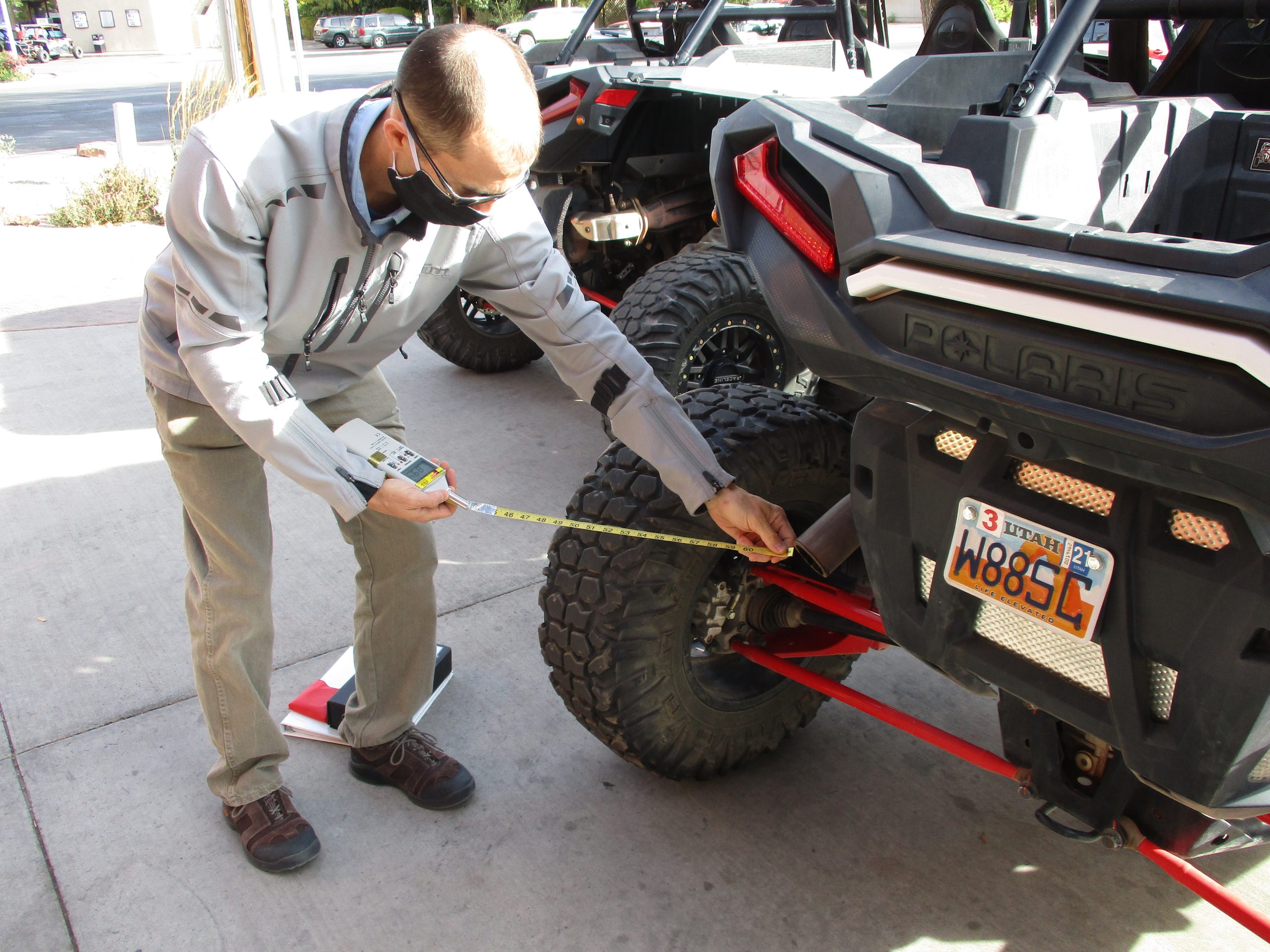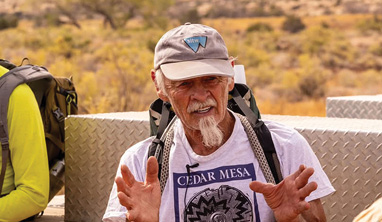Some information may be outdated.
City and county officials recently passed measures to address UTV noise in town, including a moratorium on licenses for new UTV rental and guide businesses and slower speed limits for off-road vehicles. It remains to be seen how effective these measures will be in reducing noise and improving quality of life for Grand County residents.
Already, however, among both UTV advocates and critics focused on noise reduction, there are skeptics who think local officials should be taking a different approach to the problem of UTV noise in town.
Clif Koontz is chair of the Grand County Motorized Trails Advisory Committee and director of the nonprofit Ride with Respect, a group focused on motorized trail access, stewardship, and fostering harmony across different user groups.
Koontz has been working with UTV enthusiasts and local officials to identify the most effective solutions to the noise problem. In an Oct. 19 letter to the city council and county commission, Koontz offered three suggestions, including improved education, working with UTV manufacturers, and the implementation of a standard known as the J1287, or the “20-inch test.”
20-inch test demonstration
The 20-inch test was created in 1980 by the global association of engineers SAE International to test noise from off-highway motorcycles. It has been updated and revised to be applicable to various types of vehicles, including off-road motorcycles, snowmobiles, ATVs and UTVs.
On-site with the Moab Sun News, Koontz demonstrated the 20-inch test on several stock vehicles at High Point Hummer, a local UTV rental and guide company owned by Scott and Lori McFarland. Using a sound level monitor donated by the American Motorcyclist Association, a 20-inch measuring tape, and a portable tachometer, Koontz took readings while Scott McFarland revved the engines. Koontz referred to the SAE manual, which has updated procedures for each new vehicle model, to find the appropriate RPM at which to test each vehicle. The small tachometer, perched on the back of the vehicle and waving a yellow indicator, allowed Koontz to verify that the RPMs were correct.
“We got 95 on that one, because of that rattle—maybe it would have been 94 otherwise,” Koontz told McFarland after the test of the first vehicle, a 2020 Polaris RZR XP, commonly called a Razor.
The test is designed to measure the noise emitted at a vehicle’s regular operating speed, or cruising speed. If the monitor detects 96 decibels or less at 20 inches, SAE engineers have determined that that corresponds to 82 decibels or less at a distance of 50 feet, a standard used in many state and municipal ordinances. Noise caused by conditions beyond the vehicle’s stock components, like a loose or rattling heat shield, can contribute to the sound emitted. Still, the stock Polaris RZR passed the J1287, coming in at one decibel under the 96-decibel limit.
Koontz thinks the SAE J1287 could be used to identify and cite modified vehicles, helping eliminate the loudest machines. The test is designed to be done on a stationary vehicle in an open area. As long as the ambient sound is at least 10 decibels lower than the measured sound level emitted from the vehicle, the test is scientifically valid.
Koontz next tested a 2020 Can-Am model.
“This is the fastest, most powerful side-by-side made,” said McFarland. “This is twice as fast as the one we just tested.”
The Can-Am was noticeably quieter than the Polaris, which McFarland explained is due to its three-cylinder turbo engine, in contrast to the Razor’s two-cylinder engine. He compared the engine sounds to those of different drums.
“That engine is like a snare drum,” he said of the Polaris. He described the Can-Am engine as “like hitting a bass.”
The Can-Am clocked in at 91 decibels on the sound level monitor.
“Except for somebody that’s screaming down the street super fast—if they’re on a stock Can-Am, they’ve never bothered anybody,” said Koontz.
McFarland said the Can-Am, the quieter and higher-performance model, costs about $10,000 more than the Polaris Razor.
McFarland noted that Razors are by far the most popular side-by-side currently on the market. He explained that the Razor, when it was first released, was “a game-changing machine,” with a dramatically increased performance level over what existed at the time.
A third model, made by Kawasaki, measured 93 decibels in the 20-inch test.
Each test took only a couple of minutes to conduct. Meanwhile, the nearby busy Main Street roared with noise from all kinds of traffic, including UTVs, trucks, and motorcycles. Koontz and McFarland are familiar enough with engines to identify vehicle types by their sound. Several times during the demonstration and discussion, the two cocked their ears to a loud engine noise in the distance and rattled off the vehicle type and whether it had been modified.
Koontz suggested the city and county impose three types of noise ordinances. The first, which is already in place, can be used to enforce event-based noise violations. A second ordinance, aimed at vehicles, could be implemented using the 20-inch test. The 20-inch test could also be used to regulate large UTV-based events like Rally on the Rocks. A third ordinance would target noisy driving behaviors like intentionally revving engines at stoplights.
What’s legally admissible?
In an Oct. 13 City Council meeting, Moab City Police Chief Bret Edge described one noise enforcement option as a large-scale checkpoint stopping all traffic, advertised in advance and staffed by at least six officers. Such an operation would have to stop all kinds of vehicles in a predetermined fashion—officers would not be able to single out UTVs.
This approach would be more complex and costly than the method demonstrated by Koontz, but Simonson and Edge said that they believe that strict protocols and standards are required for citations to be defensible in court.
In an email to the Moab Sun News, Edge said he believes a checkpoint is the only way to successfully guarantee both the ideal conditions for the test and officer safety. For example, the test must be conducted at least 16 feet from sound-reflecting surfaces and in wind speeds under 20 m.p.h. Without the structure of a checkpoint, Edge said placing officers behind pulled-over vehicles to conduct the test could put them in danger.
City Attorney Laurie Simonson also expressed concerns about the legal viability of cases, referencing legal cases from elsewhere in the U.S. where citations were thrown out because defendants challenged the accuracy of the sound level monitoring device used or claimed that ambient sound interfered with test results. It’s unclear whether such cases used the standardized 20-inch test.
Education
Another of Koontz’s preferred approaches for noise control is improved educational efforts: he suggested requiring UTV operators to complete a course, watch a video before renting or operating a UTV or complete an exam.
Koontz acknowledged the county’s educational video for off-roaders called “5 Tips for a Great Adventure in Moab,” which touches briefly on courtesy, as well as the “Throttle Down in Town” campaign. However, he thinks the county could be doing a lot more to require more thorough and widespread education.
Industry shift?
Koontz’s other suggestion is persuading UTV manufacturers to shift toward quieter models, though he noted that there are limits to how quiet a sport UTV can be.
“There are four things you’re trying to achieve with the muffler,” Koontz explained. “One is to muffle the sound—but keep the weight down, keep the performance up, and then the final one is to keep the price down. If you’re going to muffle it further, it’s going to have to be either heavier, more expensive or have less power. But it really comes down to priorities.”
“There’s a large segment of owners that want a quieter machine,” said McFarland, noting that many use UTVs for hunting or camping. Koontz said the loud machines are appealing for a small minority, but for most users enjoying all-day social rides with friends and family, quieter machines would be a boon.
Koontz and McFarland have hope that more consumer pressure could help shift manufacturers’ priorities towards quieter models.
“We really want to see the industry change. We really want them to get quieter,” said McFarland.
UTV businesses bring in taxes, owners say
McFarland said it’s been a busy season at his shop, with tours consistently sold out.
According to McFarland, High Point Hummer has paid $172,000 in taxes into city and county coffers this year so far, not including taxes that have gone to the state. Short-term vehicle rentals in Grand County incur a 9.5% sales tax; combined with other sales taxes, each UTV rental is charged an 18.25% tax.
Both Koontz and McFarland consider the financial benefits of the UTV industry to local governments to be a compelling reason for officials to commit to effective solutions that don’t alienate or damage that industry.
McFarland said he understands the moratorium on new UTV business licenses.
“I see the point; I also see that our town needs money,” he said.
After a decimated spring tourist season, he said the town shouldn’t risk deterring any user group from coming to Moab and to vacation and spend their money.
Both Koontz and McFarland foresee the reduced OHV speed limits creating more problems than they solve, as residents get stuck behind slow-moving vehicles, or OHVs conform to the prevailing speed in spite of the special limits.
“Positive solutions—that’s where we really want to go,” McFarland said. “Instead of shutting things down, we want to just tweak them, so they’re not a negative.”
“It really comes down to priorities.”
– Clif Koontz
Appreciate the coverage? Help keep local news alive.
Chip in to support the Moab Sun News.





